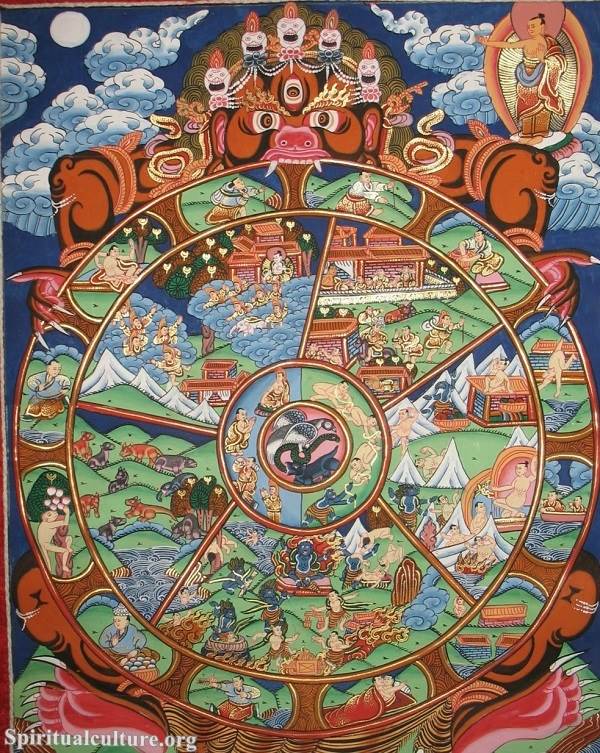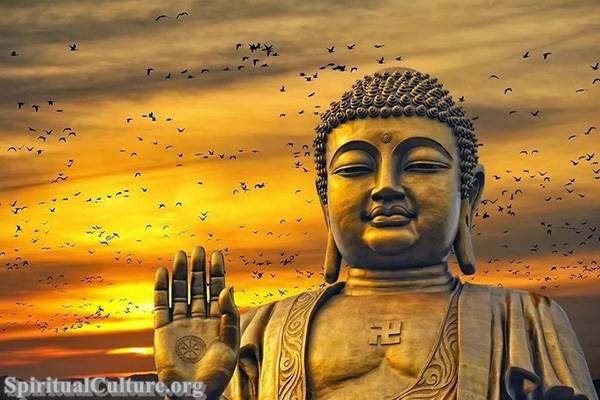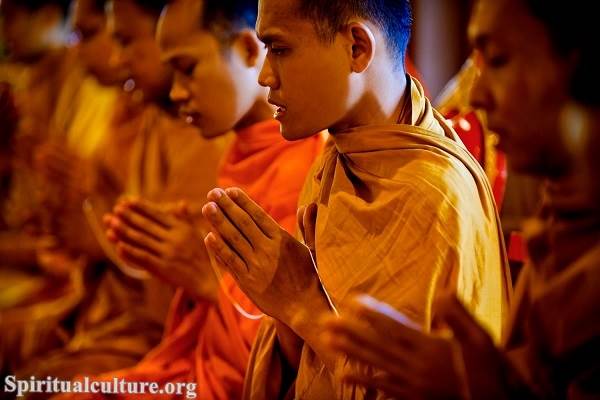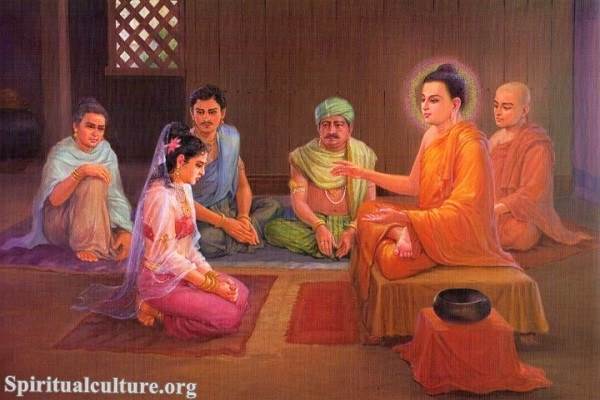Buddhism is a profound and intricate spiritual tradition that spans more than two millennia. It is a path of practice and spiritual development leading to Insight into the true nature of reality. Buddhist practices like meditation are a means of changing oneself to develop the qualities of awareness, kindness, and wisdom. Throughout its long history, Buddhism has developed a rich tapestry of symbols and iconography. Each symbol carries a unique meaning that helps to guide practitioners along the path to enlightenment. What is the symbol of Buddhism? This article will explore some of the most significant Buddhism symbols and their meanings.
The dharma wheel symbol in Buddhism
The dharma wheel, also known as the dharma chakra, is a symbol of Buddha’s teachings and represents the path to enlightenment. It is typically depicted as a wheel with eight spokes, representing the Eightfold Path, a set of principles that the Buddha taught to end suffering and attain enlightenment.
The dharma wheel is often used as a decorative element in Buddhist art and architecture. It is also depicted on the national flags of countries with significant Buddhist populations, such as Bhutan and Thailand.

The dharma wheel is a powerful and widely recognized symbol in Buddhism. It represents the Buddha’s teachings on how to end suffering and achieve enlightenment, and it is an important part of the spiritual path for Buddhists. The eight spokes of the dharma wheel represent the Eightfold Path, which consists of the following principles:
– Right understanding: understanding the Four Noble Truths and the nature of reality. The right intention is to follow the path to enlightenment and cultivate compassion and kindness.
– Right speech: the practice of speaking truthfully and avoiding harmful speech.
– Right action: acting with compassion and avoiding harm to others.
– Right livelihood: the practice of choosing a career that does not cause harm to others.
– Right effort: following the path and cultivating positive qualities.
– Right mindfulness is being present and aware of one’s thoughts and actions.
– Right concentration is cultivating a focused and concentrated mind through meditation.
Together, these principles form a path Buddhists can follow to end suffering and achieve enlightenment. The dharma wheel reminds of this path and symbolizes the Buddha’s teachings.
In addition to the dharma wheel, several other important symbols in Buddhism are commonly used in art, architecture, and ritual. These Buddhist symbols can vary depending on the specific tradition or school of Buddhism, but some examples include the following:
The lotus flower symbol in Buddhism
In Buddhism, the lotus flower symbolizes spiritual awakening and the potential for enlightenment. It is often depicted in art and literature as a symbol of purity, spiritual growth, and the ability to rise above suffering and achieve a state of peace and happiness.

The symbolism of the lotus is derived from the fact that it grows out of muddy, murky waters and remains untouched by dirt and grime, emerging as a beautiful and pure flower. This is seen as a metaphor for the human journey toward enlightenment, where one must rise above suffering and the distractions of the material world to reach a state of spiritual clarity and understanding.
The lotus is also associated with the bodhisattva, the being on the path to enlightenment but who voluntarily delays their own nirvana to help others achieve enlightenment. The lotus is often depicted as the seat or throne of the bodhisattva, representing their spiritual purity and enlightenment.
Overall, the lotus is an important symbol in Buddhism and is revered for its beauty, purity, and spiritual significance.
The stupa symbol in Buddhism
A stupa is a mound-like or hemispherical structure used as a meditation place in Buddhism. It is often seen as a symbol of the Buddha’s enlightenment and the path to enlightenment.
The stupa typically contains relics of the Buddha or other important Buddhist figures, and smaller shrines or other architectural elements often surround it.
The design of the stupa can vary widely, but it typically has four elements: a base, a dome, a spire, and a finial. The base represents the earth, the dome represents water, the spire represents fire, and the final represents air. Together, these elements represent the four elements that make up the physical world.
In addition to serving as a place of meditation, stupas are often used to make offerings to the Buddha or other important figures in the Buddhist tradition. Pilgrims and worshippers may offer flowers, incense, or other items at the stupa to express devotion and seek blessings. Some stupas are also used as a place to recite prayers or perform other religious rituals.
In addition to their spiritual significance, stupas are also important symbols of Buddhism and are found in many different countries where Buddhism is practiced. They are often used as landmarks and can be seen as a way of spreading the teachings of the Buddha to a wider audience.
The stupa has a long history and can be found in many different countries where Buddhism is practiced, including Nepal, India, Sri Lanka, and China.
The Bodhi tree symbol in Buddhism
The Bodhi tree is a symbol of enlightenment in Buddhism. According to tradition, the historical Buddha, Siddhartha Gautama, achieved enlightenment, or bodhi, while sitting beneath a Bodhi tree.
The term “Bodhi tree” is also used to refer to the species of tree under which the Buddha is said to have attained enlightenment, which is identified as the sacred fig (Ficus religiosa).
The Bodhi tree is considered to be a symbol of the Buddha’s attainment of understanding and wisdom, and it is often depicted in art and literature as a means of representing the Buddha’s enlightenment.
In Buddhist texts, the tree is also referred to as the “tree of wisdom” or the “tree of understanding.” The Bodhi tree is an important symbol in many Buddhist traditions and is often associated with the practice of meditation.
In the Buddhist tradition, the Buddha’s enlightenment is often described as a sudden, profound realization of the true nature of reality. According to the traditional story, the Buddha sat beneath the Bodhi tree for seven days, contemplating the nature of existence. On the seventh day, he reached a state of enlightenment, understanding the causes of suffering and the path to liberation from suffering. The story of the Buddha’s enlightenment under the Bodhi tree is a central part of the Buddhist tradition and is often depicted in art and literature.
The Bodhi tree is also associated with the concept of “bodhicitta,” which is a term used in Buddhism to refer to the awakened mind or the aspiration to attain enlightenment for the benefit of all beings. In this context, the Bodhi tree symbolizes the aspiration to cultivate an open, compassionate, and aware mind and use this awakened mind to benefit others.
In Buddhist teachings, the Bodhi tree is often used as a metaphor for the journey towards enlightenment. Just as the Buddha sat beneath the Bodhi tree and attained enlightenment, Buddhists are encouraged to seek understanding and wisdom through their own practice. The tree is also seen as a reminder of the potential for growth and transformation and the possibility of attaining enlightenment through dedication and effort.
The swastika symbol in Buddhism
In Buddhism, the swastika is a sacred symbol typically associated with good fortune, prosperity, and the Buddha’s teachings. It is commonly used as a symbol of the Buddha’s teachings and often used as a decorative element in Buddhist temples and other religious buildings.
The swastika is often found on temples, prayer flags, and other religious objects in Buddhist cultures and is sometimes placed on offerings or used in rituals.
The swastika is typically depicted with four arms of equal length, each of which is bent at a right angle. The arms are usually oriented in a clockwise direction, although some traditions depict the arms oriented counterclockwise.
The swastika has a long and complex history, and its symbolism has varied widely over time and across different cultures. In some ancient cultures, the swastika was believed to be a symbol of the sun and was associated with various deities and mythological figures.
In Hinduism, the swastika is a sacred symbol that is often associated with the god Vishnu and is used in Hindu rituals and ceremonies.
The Tibetan prayer flag symbol in Buddhism
In Tibetan Buddhism, prayer flags are used to promote peace, compassion, strength, and wisdom. The flags are traditionally made of cotton, and each one features a different color and symbol. The colors of the flags represent the elements: blue symbolizes the sky and space, white represents the air and wind, red represents fire, green represents water, and yellow represents the earth. The Buddhist symbols on the flags include the Eight Auspicious Symbols, the Wheel of Life, and other auspicious signs and symbols.
Prayer flags are typically placed outside, where the wind can carry the prayers printed on them to all beings. The flags are often seen fluttering on rooftops, mountain passes, and high places. They are believed to bring good fortune to those who erect them and to all beings in the area.
In Tibetan culture, it is common to see prayer flags placed in strings or garlands. The flags are usually inscribed with prayers, mantras, or other sacred phrases, and the prayers are believed to become more powerful as the flags flutter in the wind. The idea behind the use of prayer flags is that prayers and good intentions will be carried on the wind to benefit all beings.
There are many different kinds of prayer flags, including horizontal flags placed on rooftops and poles, vertical flags placed on poles or hung from trees, and small hand-held flags that can be carried with you or placed in special locations.
Prayer flags are an important part of Tibetan Buddhist tradition and culture, and they are used in many different rituals and ceremonies. They are also a common sight in Tibetan communities around the world.



